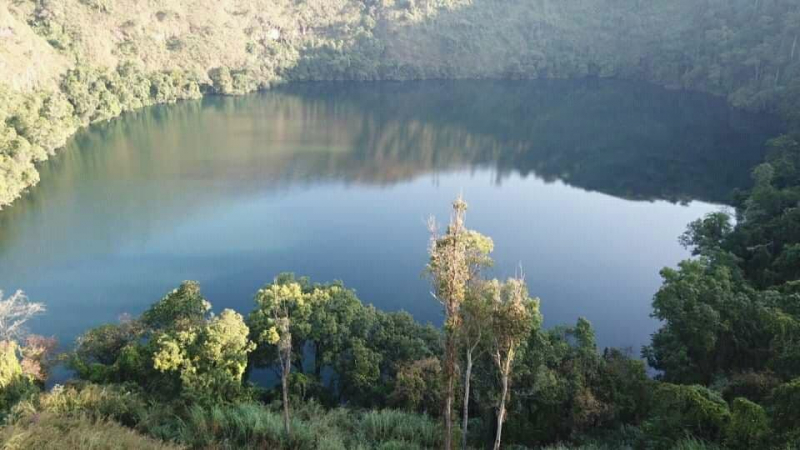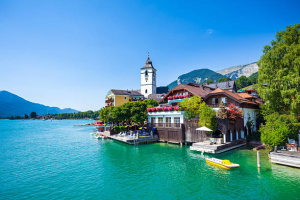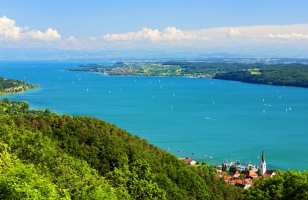Top 6 Most Beautiful Lakes in Cameroon
Although lakes are located on land and are not an ocean, they constitute a component of the earth's water cycle just like the much bigger seas. Lakes abound in ... read more...Cameroon. The following list refers to the most beautiful lakes in Cameroon.
-
The peak of Mount Manengouba, a dormant volcano with a sizable caldera at its summit, is the village of Bangem, which is located above the smaller town of Mbat. Man Lake and Woman Lake are two large, distinctly dissimilar crater lakes in the caldera's plain. The Bakossi locals' traditional legend has a strong foundation in the lake's outward appearances and atmospheres, which serve as a testament to the long-standing and intense hostility between Man and Woman Lakes' spirits.
Woman Lake, the biggest of the two, has an accessible, clean shoreline that provides local ranchers with water, fish, and crabs for their cattle. The waters of Woman Lake are ruffled by gusts while the surface sparkles in the sunlight.
Man Lake is a striking contrast. The surface of Man Lake is still flat, opaque, and unreflective on the same sunny day. Depending on the spirit's attitude, its watercolor changes daily between black, green, and brown. Man Lake has very steep slopes, making it impossible for anyone to reach its waters without falling. Man Lake bathing is only permitted during ceremonies and by spiritual men, although bathing in Woman Lake is a daily occurrence.Furthermore, nothing floats on the lake's surface, and rocks hurled from the rim (no matter how hard or precisely) cannot reach the water, proving that the spirit guards his waters from disturbance. It's as though a field repels all such attempts, yet once sunk, there is no way to get out of Man Lake's waters. It's incomprehensible why Man Lake should have such a temperamental and harsh personality.
It is believed that the storms that roll over the mountain and cover Bangem and other adjacent towns are caused by fights between the ghosts of Man and Woman Lakes.Location: Hauts Plateaux

Photo: Atlas Obscura - Man & Woman Lakes 
Photo: Atlas Obscura - Man & Woman Lakes -
The high highland plateaus of western Cameroon are home to Lake Baleng, also known as Lake Sabichi, which is a crater lake in the Baleng chiefdom. It is roughly 6 kilometers from Bafoussam's city center.
The town of Baling is located in the Mifi district and has a stunning natural and cultural legacy, including the Baleng Lake, Meuhgam Cave, superb Forest, and Chiefdom. A natural treasure, Lake Baleng draws numerous local and international tourists every day. To get there, you must descend a flight of steep steps that bring you right up against the shore. You will certainly come across a little cabin on your left and a big stone covered in salt and palm oil on your right. In fact, the Baleng revere the lake's edge as a sacred location where they regularly perform religious rites and view the lake's waters as a source of purification.
The most inventive-or difficult-activity during this visit is to hike into the deep forest that almost completely encircles the lake. It will take you around 30 to 45 minutes to complete the route, depending on the season, and will need you to climb minor slopes, navigate stone reliefs, weave among trees, grab hold of lianas, and occasionally wait for other tourists who are exhausted.Location: Cameroon West Region

Photo: Journal du Cameroun - Lake Baleng Video: Kamer Xpose - Lake Baleng Bafoussam Cameroon Cinematic -
Lake Ossa is one of the most beautiful lakes in Cameroon, with a surface area of about 4,000 ha. It is about 12 km west of the city of Edea and roughly 50 km inland from the Gulf of Guinea. The lake's morphology is quite intricate and can be separated into four main sections. During the wet season, the tiny lake's maximum width is 7 km, and its maximum depth is 7 m. A 3 km long meandering canal connects the lake to the River Sanaga, which is the longest and longest river in the nation. The lake's water quality and level are governed by the river flow rate.
Location and season have an impact on the lake's perceived color and Secchi depth. During the rainy season, the Sanaga River's influence causes the water in the southeast to be opaque and have a dark, muddy color. Water in the north and west is more visible thanks to its dark apparent color, which is brought on by its muddy, black bottom.
Many wildlife species, including manatees, freshwater turtles, crocodiles, monitor lizards, snakes, and other aquatic bird species, call Lake Ossa home. The lake's most famous species, the African manatee, mostly feeds on macrophyte beds. The lake's water level has a significant impact on the presence of macrophytes.Location: Littoral

Photo: Global Water Partnership - Cameroon: Lake Ossa 
Photo: Global Nature Fund GNF - Lake Ossa -
Lake Oku is a remarkable crater lake in the Northwest region that is encircled by dense vegetation. Many visitors either take a motorbike there and hike back, or they hike there and take a motorbike back. The lake is open to visitors, and swimming there is free. To reach the Oku area, you must go through Fulani territory, where you will be awed by the lake's breathtaking scenery and local crops including cocoyams, coffee, and corn. From Belo, the ascent takes about five hours. The trip takes between one and two hours if you decide to take a bike taxi. The hike back from the lake takes around 4 hours and passes through the Anyajua settlement.
According to legend, the spirits of the land's predecessors have endowed this lake with magical and therapeutic properties. It is well-respected and frequently maintained clean.
The lake is the Lake Oku Clawed Frog's sole known habitat. BirdLife International established the nearby Kilum-Jim Forest as a wildlife reserve, which is home to numerous uncommon species.Location: Bamenda Plateau

Photo: Wikipedia - Lake Oku 
Photo: Mapio.net - Lake Oku -
Boboyo, a town in the Far North of Cameroon, is home to numerous charming local tourist attractions, including the crocodile lake. Nearly 8 km away from the town of Kaélé, it is situated in the Mayo-Kani department's administrative center.
The Crocodile Lake of Boboyo draws admiration and attention from both domestic and international tourists due to its enigmatic and unique charm. When traveling by car, it takes just ten minutes to arrive to this incredibly gorgeous lake. If you're already in the city, you can also travel there on a motorbike for 500FCFA.
The place is open to the public and there are free benches where you can relax and watch the crocodiles emerge from the water. Because they are accustomed to being fed by tourists, crocodiles are not dangerous. Above all, don't be afraid to take a quick stroll around the lake, at the base of Mount Kaélé, to better appreciate the beauty of this breathtaking setting. If you ever find yourself in the Far North, make sure to visit this stunning location to see these crocodiles.
Location: Boboyo village

Photo: Luxecam Tours - Crocodile Lake In Boboyo 
Photo: Luxecam Tours - Crocodile Lake In Boboyo -
Lake Nyos closes the list of most beautiful lakes in Cameroon. Located around 315 kilometers (196 miles) northwest of Yaoundé, the country's capital, Lake Nyos is a crater lake in the Region of Cameroon. In the Oku volcanic plain near the Cameroon line of volcanic activity, Nyos is a deep lake perched high on the face of a dormant volcano. The lake's water is held back by a volcanic dam.
Under the lake, there is a pocket of magma that seeps carbon dioxide (CO2) into the water, turning it into carbonic acid. Only three lakes are known to be as saturated with carbon dioxide, and Nyos is one of them. As a result, it is vulnerable to limnic eruptions (the others being Lake Monoun, also in Cameroon, and Lake Kivu in the Democratic Republic of Congo and Rwanda).
In 1986, Lake Nyos abruptly released a significant cloud of CO2, presumably as a result of a landslide, which suffocated 1,746 people and 3,500 cattle in adjacent towns and villages, the most noteworthy of which was Chah, which was abandoned as a result of the catastrophe. It wasn't entirely unusual, but it was the first instance of a significant asphyxiation brought on by a natural occurrence. A degassing tube that siphons water from the bottom layers to the top, enabling the carbon dioxide to leak in safe amounts, was built in 2001 to stop a repeat of the incident. In 2011, there were added two tubes.
The lake is currently dangerous since its natural wall is eroding. This natural levee might give way as a result of a geological tremor, causing water to flood into settlements downstream all the way into Nigeria and allowing significant volumes of carbon dioxide to escape.
Location: northwestern Cameroon

Photo: cameroon-report.com - Lake Nyos 
Photo: www.jst.go.jp - Magmatic Fluid Supply into Lakes Nyos



























